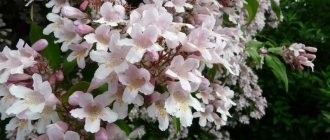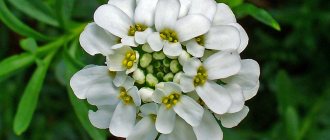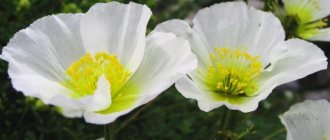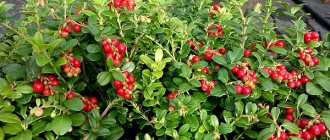General description of the plant
China is considered to be the birthplace of this small shrub. It has a dense openwork crown with small leathery leaves of variegated or green color.
The branches are very long , capable of climbing onto a support, but the height of the bush itself does not exceed 60 cm. The plant has varieties of different frost resistance, some of them can withstand not very severe winters.
Due to the properties of Euonymus branches to grow on the sides, it is used as a ground cover shrub. They try to plant in large, dense groups and in ribbons of different widths.
It goes well with spruce trees, thujas, junipers, and acts as a background for them. In the home garden it looks great among groups of plants and mixed compositions, stripes of various shrubs, landscapes with stones and alpine slides.
The photo shows “Euponus Fortune”:
Caring for euonymus at home
Low-growing species are grown at home. Due to constant pruning, a different type can be controlled in the rise - it will turn out to be an amazing decoration for a window sill or desktop.
Lighting
Euonymuses with green foliage perform equally well in shade and in bright light. Variegated species require fairly bright light. In each option, it is necessary to protect from the midday rays of the sun.
Air temperature and humidity
It's important to stay cool. In summer, the air temperature should be between 18–25° C; in winter, reduce it to 6–8° C. When temperatures are predominantly high, leaves drop.
Air humidity is not of great importance, because the leathery leaves are protected from excessive evaporation. Sometimes wipe off dust with a wet sponge, dip under a cold shower.
Watering and fertilizing
Water constantly, modestly, remove excess water from the pan.
Between March and September, add mineral fertilizers every month.
Pruning and replanting
Every spring you organize pruning, giving the desired shape to the plant. Constantly pinch out young shoots.
Replant every 2-3 years. Choose a spacious, normal depth, strong capacity. Place a drainage layer at the bottom. The soil required is light, nutritious, approximately of the same structure: leaf, turf soil, leaf humus, sand.
Home care
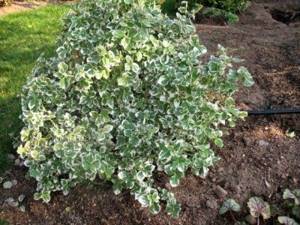
Due to its slow growth and year-round decorativeness, it can be kept in both open and protected ground conditions.
At the same time, the methods of care differ in no way from each other, and consist of several techniques and rules.
Actions after purchase
"Euponymus Fortune" is purchased in a pot. When purchasing it, you must carefully consider it for the presence of pests and diseases.
Next, the shrub is planted in a permanent place. The rules for planting are no different from transplanting, but after this the plant is not fed with watering until the root system has taken root.
Trimming
The growth of the bush is very fast. To form the required shape, it is periodically pruned. As such, formative pruning is not necessary, but aesthetic shape is achieved by removing dead and protruding branches.
Watering
“Euonymus” is characterized by drought resistance and does not tolerate stagnant moisture. You need to water the plant according to the principle - it is better to water less than to fill it “in reserve”.
But you need to monitor watering of young plants, and do this more often due to the weaker root system.
In winter, in closed soil conditions and at low temperatures, watering is reduced , and in summer, care is taken to ensure that the soil in the container does not dry out.
Transfer
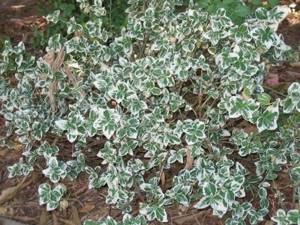
The soil removed from the hole is mixed with well-rotted compost.
Removing the seedling from the pot or previous location is done carefully, and planting is done at the same depth as before.
After planting, the soil is compacted.
Growing
Mature shrubs are watered up to four times during the season, young ones are often more abundant, especially during periods of drought. The compacted soil is loosened and regularly mulched with peat soil mixture to a depth of 6 cm.
For the winter, young plants (up to 2 years old) are covered with dry leaves, but older plants do not need to be covered. In the fall, digging is done, under which slaked lime is added.
Reproduction
The easiest way to propagate Euonymus is by rooted shoots. If you press a branch to the ground, it produces roots at this point.
After a certain time, it is cut off and transplanted to a new place. To make the process faster, the pressed shoot is sprinkled with a little soil.
Another method of vegetative propagation is cuttings. To do this, non-young shoots are selected and cut with pruning shears at an angle of 45° to a length of up to 12 cm. The cuttings are planted in a moist soil mixture, and a rooting agent is used for better survival.
Euonymus can be propagated by seeds. To do this, in the first half of spring, the beds are sown to a depth of 2 cm in a special substrate.
It is prepared by mixing one part turf soil, two parts humus and one part sand. The emergence of seedlings occurs on average after 20 days.
In closed ground, sowing is done at the end of January, and by the end of summer you can get strong seedlings that produce natural growth.
Temperature
The plant prefers moderate temperatures, up to 25°C in summer, and about 8°C in winter, but not higher than 12. It tolerates mild frosts well, but too much heat has a negative effect on the plant.
Lighting
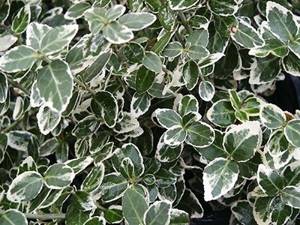
But it is better for direct exposure to the sun to occur in the morning or evening.
Guided by this rule, you need to choose a suitable place to place the euonymus.
The lack of light is very noticeable in winter in closed ground conditions.
At the same time, the leaves turn yellow and growth stops. During this period, additional lighting with special lamps is required.
Euonymus in open ground and at home (care)
Let's look at how to grow this plant in summer cottages and apartments.
Outdoor care
In order for the euonymus to please the gardener for many years, it needs periodic care.
Landing. Planting can be done in early spring or autumn - in October . Most euonymuses prefer slightly alkaline or neutral soils, so ash must be added to the planting holes. They are not very demanding of lighting, but in the shade, variegated varieties can lose their brightness and turn green.
Watering. You need to water the euonymus sparingly . It has dense, leathery leaves, which allows the plant to slowly evaporate moisture and therefore the soil does not need constant moisture. It is better to mulch the tree trunk circle, which will help cope with soil drying out in the summer.
Feeding. Euonymus needs to be fed 2 times a year . The first fertilizing is done in the spring and various organic fertilizers are used. The second is carried out in early autumn and phosphorus-potassium mineral fertilizers are used for this.
Trimming. Euonymus needs constant formative pruning . They can be used to create beautiful examples of topiary art.
Preparing for winter. Euonymus winters well in the middle zone, but young specimens should be covered with non-woven material in the first years.
Home care
Euonymus is used for apartments and winter gardens:
- Japanese;
- Fortune.
This plant does not require special care, but you need to know some subtleties.
Lighting. At home, euonymus is placed on windows with bright, but not direct light. Openings with western or eastern orientation are suitable.
Temperature. These plants do not like very high temperatures in summer, and in winter they must be kept in a cold room at a temperature of +4 degrees.
Humidity. Euonymus has leathery leaves and therefore this plant practically does not need additional humidification of the surrounding air.
Soil and fertilizing. For planting home-made euonymus, any soil with a neutral reaction, which is offered in stores for decorative foliage plants, is suitable. Feed the flower once a month, using fertilizers that do not contain large amounts of nitrogen.
Trimming. Homemade euonymus needs constant pruning, as this plant grows quite quickly (annual growth can be 20 cm).
Benefits and harms
“Euonymus” as an ornamental plant grows well both on open balconies and terraces, personal plots, and in parks, squares, near monuments, office buildings, and other urban landscaping sites, without requiring special care.
The only drawback is its easy damage by pests , in which the bush will act as a breeding ground for harmful insects. This can be easily prevented by conducting regular plant inspections and timely application of pesticides.
Features of growing a flower
Euonymus is unpretentious, resistant to gas pollution and city dust, does not require special care and is well suited for growing in temperate latitudes of our country.
There are evergreen and deciduous species. The former are mainly used indoors. The shrub is frost-resistant and winters well in the garden at the dacha.
Euonymus needs to be fed and watered, regardless of whether it grows in the garden or in the room. The indoor specimen must be created at an acceptable temperature. Tolerates shade well. Fertilizing is done with an emphasis on good fruiting.
Diseases and pests
Fortune's euonymus, like other garden plants, is affected by certain pests and diseases.
To combat them, chemical control agents and gardening techniques are used:
- When powdery mildew appears , which looks like a white or brown-gray coating on the leaves, treat with a fungicide. Traditionally, this is done with the safest means - Bordeaux mixture. But it is also possible to use specialized means that are more effective. In case of focal damage, diseased branches are removed. In case of spider mite infestation, which is determined by the appearance of silvery dots on the upper side of the leaf and traces of cobwebs below, treatment is carried out with an acaricide. Colloidal sulfur is considered the most environmentally friendly product;
- When affected by other pests - aphids, mealybugs or caterpillars, standard means of protecting the garden from pests are used. Inspection of plantings should be carried out regularly, since damage to shrubs by insects occurs more intensively in comparison with other garden plants.
Problems, diseases and pests of a flower
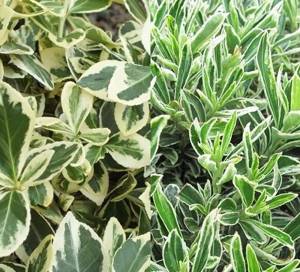
Home euonymus can shed its leaves when the soil is waterlogged or the temperature is too high in winter.
Diseases of euonymus are powdery mildew and trunk rot. These are fungal diseases and are treated with fungicides.
Pests that attack euonymus are aphids, spider mites, mealybugs and caterpillars. It is better to remove caterpillars manually along with their nests. Other pests need to be controlled using insecticides - contact and systemic.
Fortune's euonymus: planting and care, photo
Currently, owners of suburban areas have begun to pay more and more attention to the cultivation of plants used to decorate flower beds and borders of garden paths.
In this case, it is worth paying attention to Fortune's euonymus - an evergreen shrub. There are several legends about the origin of this unusual plant. Euonymus was created by an evil witch who wanted to create a poisonous plant to take revenge on a person, but then she changed her mind and made it medicinal, and she herself turned into a robin bird, which alone is not afraid of this bush. According to another legend, the goddess Flora created the euonymus from lost earrings and a brooch. At the site of the loss, a bush has grown that blooms with catkins.
How to deal with possible diseases and pests
To prevent treatment of the plant and extermination from various pests, it is necessary to know the enemy by sight and carry out preventive measures in a timely manner. To do this, the shrub should be treated with fungicides in the spring. Proper watering and placing the plant in a sunny place will protect it from a variety of pests and fungal diseases.
But still, if for some reason these measures could not be taken, below are the diseases and pests that the euonymus may encounter:
- Powdery mildew.
This disease affects the leaves of the plant, which become covered with white spots and then dry out completely. This disease can be treated using a traditional method, for example, using Bordeaux mixture. Or purchase special products to combat powdery mildew. After treatment, damaged parts of the plant need to be trimmed.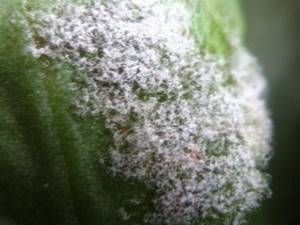
- Spider mite. If this pest has infected a shrub, then silver specks will be visible at the top of the leaves, and there will be cobwebs at the bottom of the leaves. To get rid of this scoundrel, you can use a special remedy called an acaricide or the safest remedy - a solution of colloidal sulfur.
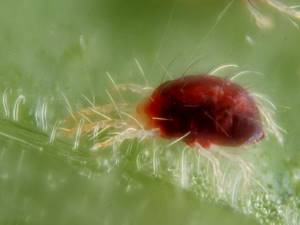
- Aphid.
To combat aphids, use specialized or folk remedies.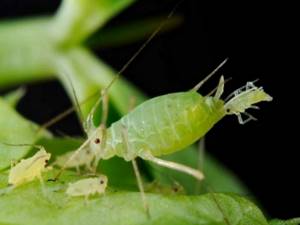
Description
to European countries from China , where it was first discovered and described by the English biologist Robert Fortune. Translated from Latin, the name of the shrub means “alluring beauty.”
Fortune's euonymus is an evergreen shrub. More than two hundred species of this plant grow under natural conditions, which can retain foliage for the winter or shed it in the fall. Euonymus has earned special attention from gardeners due to the unusual bright color of its leaves.
Fortune's euonymus in landscape design photos is a low shrub, the height of which does not exceed half a meter, but the branches of the bush can reach a length of three or more meters. Let's describe it:
- Nodules form on the branches, from which roots grow, thanks to which the plant spreads along the ground and entwines the supports.
- The crown is solid, openwork because the leaves are located very close to each other.
- The leaves are small in size, located on short stalks and have an oblong, slightly elongated shape.
- Leaves are the main decoration of the bush. The leaves often have a two-tone color: a bright green color combines favorably with a gold or silver tint in the summer. In autumn the leaves turn red, yellow, white, orange.
Euonymus blooms very rarely .
The flowers resemble earrings in shape and have a pale greenish color. They can only be seen in the wild. Euonymus berries are poisonous.
Euonymus is unpretentious , tolerates polluted air well, grows in the shade and is easy to care for.
Euonymus is frost-resistant and grows well in conditions with low temperatures in winter.
Planting in open ground
Creeping euonymus - planting, care and growing in the garden
To grow a beautiful euonymus bush, planting and care must be competent and with knowledge of the characteristics of the plant.
What is needed for planting
If you plan to plant euonymus in open ground, then it is worth determining the time and place of planting. The best period for good adaptation and active growth is early spring.
It is worth preparing in advance material for drainage, fertilizer, lime (when planting in acidic soils). It is also better to dig a hole for planting in advance, about two weeks before planting the seedlings in the ground.
Soil preparation
Choosing the optimal location
Japanese euonymus (variegated) is an unpretentious plant that grows well in both sun and shade. But since this is a tropical species, it will grow more actively and have intense leaf color in partial shade.
Note! In such conditions, watering will be moderate and the leaves will be denser.
When choosing a site for planting, it is necessary to pay attention to the quality of the soil; good water permeability and air permeability, low acidity and high fertility are required. The plant is accustomed to such characteristics in its natural habitat, where euonymus has been growing for a long time. If the type of soil on your garden plot is not suitable, then when planting in a hole or trench you need to add compost, drainage material and slaked lime to reduce the acidity of the soil. You should continue to care for and monitor the acidity of the soil in future years.
Important! Due to the growth of branches, close planting with other trees or near buildings should be avoided.
Step-by-step process for planting euonymus
Step-by-step instructions on how to plant a shrub:
Step No. 1. Preparing the pit.
A hole for seedlings is dug 14-15 days before planting. Its size should exceed the volume of the root system of the planting material by 1.5-2 times. Fill the bottom of the pit with drainage material (gravel, crushed stone).
Step No. 2. Preparing the soil for filling the hole.
It is necessary to mix the soil with fertilizer and, if necessary, lime (150 g for each hole). Part of the soil should be poured into an even layer onto the drainage.
Step No. 3. Planting a seedling.
Planting material is lowered into the hole, straightening the root system. It is necessary to sprinkle the roots of the seedling with the remains of the soil-compost mixture.
Planting euonymus
Step No. 4. Watering.
Immediately after planting, the plant requires abundant watering. You need to repeat it daily for 7-8 days.
Note! When planting Japanese euonymus in boxes and flowerpots, it can be used for landscaping of an estate and as a houseplant.
Variety of types of euonymus
There are many varieties of this plant, varying in height. Euonymus can reach several meters in height and resemble a spreading tree. Varieties in the form of a bush are known.
of decorative value . These species do not have a trunk; their long creeping branches are covered with leaves tightly adjacent to each other. Typically, these plants are used in landscape design to decorate hedges, arches and fences. Several types of this shrub are most popular
- Emerald Gold . The name translates as “emerald in gold” and perfectly characterizes the appearance of this shrub. This variety has oblong, medium-sized leaves that have an unusual color: bright green in the center of the leaf blade with a golden frame around the edges. In autumn, the leaf edges turn pink to bright red.
- The shrub grows very slowly. An adult plant can reach a height of 60 centimeters. Branches creeping grow up to two meters. The plant tolerates winter cold well.
- Emerald Gaeti. This is a small compact plant, the height of which does not exceed 20-30 centimeters. The branches are not very long. The leaves have a slightly elongated ovoid shape, are colored light green, and have a white border along the edges of the leaves. The plant can tolerate very severe frosts.
- Baby . A dwarf variety of euonymus that looks like a pillow. The height of the plant does not exceed 5 centimeters. The leaves are oblong, bright green with white veins. This variety is often used as a cover plant and also for garden borders.
- Vegetus. In appearance, this variety of euonymus is closest to forms growing in the wild. The bushes grow very quickly, their height reaches 15-20 centimeters. The plant is capable of creating a dense green carpet on the surface in a short time.
Euonymus propagation
The plant propagates by cuttings or layering The young shoot is bent to the ground and deepened under the soil layer. After the roots appear, and then the sprouts, the seedling can be cut off and replanted for independent growth.
Important! Before placing the shoot in the ground, you can make cuts on it, so roots will form more actively.
Propagation by seeds is possible, but germination is so low that it is better not to waste time on this. A plant grown from a seed is formed in the fifth year. This method is more often used for rare species of euonymus.
Seeds need to be collected in the fall, after which they are immersed in a solution of potassium permanganate, and then stratified in a cold place. You can sow such seeds at the end of winter in a container that should be left in the light, covered with glass or film. The soil with seeds must be watered without allowing it to dry out.
After the first two leaves become noticeable, the euonymus is planted in pots and grown at home for another 2 years.
By dividing the bush you can propagate a dwarf variety of euonymus. Its roots are closer to the surface and it regularly produces shoots. It is important to carefully separate the young shoot from the mother bush. The separated part should be cut off by 2/3 and planted in open ground.
Root shoots can be separated in early spring. This must be done together with the clod of earth in which it grows. The offspring can be up to 50 cm in height; if higher, it can be cut off. You can plant it immediately in a permanent place, or in a plot for seedlings, until the required size is obtained.
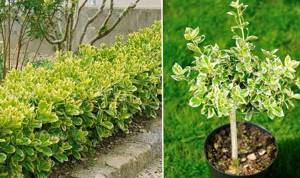
Reproduction of Fortune's euonymus
Euonymus is propagated by layering, cuttings or seeds .
Experienced gardeners prefer the vegetative propagation method, as it allows them to preserve the species characteristics and decorative qualities of the plant. Propagation by layering is the easiest way to propagate euonymus, since the plant can independently form roots on branches spreading along the surface of the ground. In this case, several young plants can be obtained from one shoot. To propagate by layering, you should separate a branch that has strong, well-developed roots and transplant it to a new location.
If Fortune's euonymus is used as landscaping on a vertical surface, then a small groove is dug near the trunk of the bush and the branches are bent into it. After the branches take root well, they are separated from the main plant and transplanted to a permanent place.
Propagation by cuttings
Propagating euonymus from cuttings is also quite simple. Young shoots up to 15 centimeters long, having several growth points, are used as planting material. They are treated with phytostimulants and planted in small containers with soil consisting of coarse sand and peat.
Plant propagation
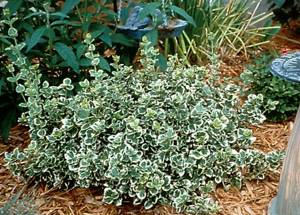
Euonymus can be propagated by seeds, layering and cuttings. All methods are suitable for both garden plants and home plants.
Reproduction methods
Reproduction of euonymus by seeds.
Seeds can be sown in autumn. If spring planting is planned, you need to soak them for several months in sand (calcined), first at a temperature of 10 - 12 degrees, and then another month at 2 - 3 degrees to improve germination.
Before planting, the seeds must be cleared of their stems to avoid rotting and treated with a weak solution of potassium permanganate. A new bush is transplanted to a permanent place only after 2 years.
Propagation by cuttings
This is the most reliable way to get a new plant. Tip cuttings are suitable for cuttings. They are cut in July and planted in sandy soil obliquely under a film. Before planting, it is recommended to treat the cuttings with heteroauxin or root.
The root system is formed by autumn. Further care as for an adult plant.
Reproduction by layering
This method is used for euonymus living in a garden plot. In the spring, the lowest growing branches are pinned to the ground, laid in a specially dug small groove, and sprinkled with soil on top. Gradually it takes root and a small shoot grows out of it. It is separated from the mother plant and transplanted to another, permanent place
Bloom. Is the plant blooming?
The value of euonymus and its decorative properties are not due to flowering. The plant blooms, but with very inconspicuous, unattractive flowers.
Planting euonymus Fortune
In order to grow a strong and beautiful bush , you should take care of the planting material.
Seedlings can be grown independently or purchased from a nursery. When purchasing seedlings, special attention should be paid to the root system, which should be well developed and not damaged. The branches must be intact, without signs of cuts or breaks, with intact bark.
Planting is carried out in spring. For the plant, it is better to choose a place that is well lit by the sun in the morning and evening. It is better to plant euonymus on an elevated area, since it does not like close groundwater, which contributes to rotting of the root system. Areas along garden paths and gazebos are suitable for the plant.
Euonymus does not require a special soil composition. But in order to grow a beautiful, healthy plant, you should prepare loose, light, fertile soil consisting of peat, humus of the turf substrate, humus and wood ash. Before planting, you can apply mineral fertilizers.
Euonymus is planted in late April–May. The plant has time to take root and sprout before the onset of winter cold. For planting, holes or trenches are first prepared, at the bottom of which a drainage layer is laid. Expanded clay, broken brick, pebbles or gravel can be used as drainage.
The excavated soil is mixed with prepared soil and placed in the planting hole. When planting a plant, do not bury the root collar. Then the euonymus is watered. The ground around the plant is mulched with sawdust or peat.
Euonymus - planting and care
Some time before planting euonymus in open ground, you need to select a position in which the seedlings will begin to effectively form. The culture prefers places protected from the wind. Sunny places or light partial shade; variegated varieties mostly require bright sun. In the shade, euonymus grows heavily, and its bright foliage color fades.
The best period for transplanting euonymus is spring or half of October, and planting with a covered root system can be carried out throughout the entire season.
Additionally, take into account the size of the crop. Certain species forms grow significantly and between them or other crops maintain approximately 1.5–2 meters.
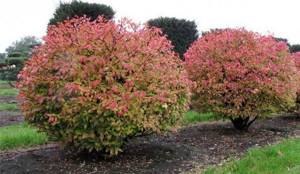
Select an area for planting euonymus with little groundwater. The plant needs a fertile, water-permeable, slightly alkaline base or with intermediate subacidity. The soil from the prepared depression is mixed together with 3 shares of fertilizer. As drainage, the bottom of the recess is lined with a layer of large expanded clay or chopped bricks.
Basically, if planting the euonymus in open soil was successful, then you will see new growth within a couple of weeks. During the rooting period, the bush will require heavy watering. The soil should not be allowed to dry out, but there is no need to water it every day. Once the plant is established, you can reduce the spraying.
Why does euonymus grow poorly after planting? The probable root cause is the lack of light, the close occurrence of groundwater, causing waterlogging of the soil, the lack of nutritional components, and the high subacidity of the substrate.
Features of caring for Fortune's euonymus
Euonymus is unpretentious and undemanding in terms of care and growing conditions. However, in order for the plant to delight with its beauty, you should follow a few simple rules for caring for the shrub.
- Watering. Euonymus easily tolerates lack of moisture for a long time, but regular watering is very important for young plants. In order for the plants to take root quickly, they should be watered at least once every 7-10 days. If the summer is hot and dry, the frequency of watering should be increased to twice a week.
- Watering adult plants is carried out as the top soil layer around them dries. Plants require frequent watering in the spring at the beginning of the growing season.
- Feeding. Euonymus needs regular feeding with mineral and organic fertilizers. Fertilizers are applied in spring and autumn. In early spring, the plant is fed with mineral fertilizers and compost; in the fall, fertilizers with a high content of potassium and phosphorus are applied.
- Trimming. The plant does not need pruning to give it decorative qualities. It is enough to carry out sanitary cleaning of the plantings in early spring, remove dried and broken branches. It is recommended to remove long shoots that can spoil the appearance of the planting.
- Shelter for the winter. Adult euonymus Fortune is winter-hardy and can withstand low temperatures well. However, when preparing for wintering, young plants should be covered. Fallen leaves, sawdust, spruce branches, and burlap can be used as covering material. When the young shoots grow up, when preparing for winter, you should focus on the plant variety planted and climatic conditions.
Caring for euonymus in the garden

Watering
Seedlings do not prefer huge amounts of moisture. Do not allow the soil to become waterlogged; short-term dryness is safer. Organize hydration according to the degree of need. When precipitation is constant, irrigation is not required at all. Loosen the soil in the tree trunk at least three times a season, 1–2 days after watering.
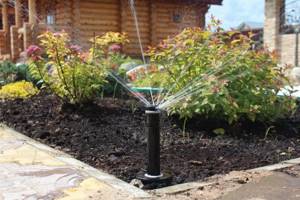
Apply group mineralized fertilizers twice a season (spring and autumn).
Trimming
Due to pruning, the euonymus will begin to branch vigorously. In order not to damage the fruiting in any way, carry out the cutting in early spring or after fruit formation is completed. The bush is given an ellipsoidal, conical shape; cultivation of a standard tree is known. During the growing season, pinch the tops, eliminate weak shoots, and thin out the bush.
Shelter for the winter
Young plantings (up to 3 years old) should be covered with spruce branches during the cold season. Mature shrubs and trees will not need cover, however, if a snowless winter is expected, it is necessary to mulch the tree trunk with leaves or sawdust.
Fortune's euonymus in landscape design
Currently, the popularity of Fortune's euonymus is growing due to the variety of shapes and colors of the plant's leaves.
Plants are indispensable in landscape design. It is used as an independent planting, for decorating lawns as a ground cover plant. Since besklet tolerates polluted air well, it is used to decorate parks and squares.
Tall varieties of euonymus are used to create hedges, borders, and alpine slides.
Decorative use of euonymus shrub
Although euonymus has long been used as a medicinal plant, in modern times it mainly plays a decorative role:
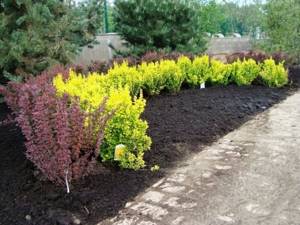
- used in urban landscaping;
- landscape designers use euonymus as a ground cover plant or vines, depending on the type and species;
- garden borders and slides look sophisticated if euonymus grows on them;
- living fences made from euonymus are ideal;
- Euonymus is successful as a container crop;
- the smallest euonymus will be able to decorate houses and apartments like bonsai;
- the combination in landscape design or in the garden of euonymus is especially attractive together with thuja, spruce, juniper, or any other coniferous tree.
Peculiarities
Fortune's euonymus is an evergreen creeping shrub. The plant, which is not yet very common as a garden crop, is just beginning to gain popularity among gardeners. The shrub belongs to the Euonymus family; its homeland is China. In natural conditions, it prefers valleys and floodplains for growth; it can often be found in undergrowth. With a small height, the shrub can reach a length of about 3 m.
The stems of the plant, in contact with the soil, form additional roots at the nodes, which very easily grow into the ground; they can also cling to the existing supports, thereby lifting the bush upward. Fortune's euonymus produces small greenish-white flowers. The fruits of the plant are bright, round in shape, they are unsuitable for food, they have poisonous properties, but are an excellent decoration for the bush.
Application in landscape design
Fortune's euonymus grows very well. And thanks to this property, it is used as a ground cover shrub.
It is planted singly very rarely; usually it can be seen in large tracts, various ribbons and dense groups.

Since the euonymus does not require careful care, it can often be seen in the city in parks, squares, near monuments, shops, office buildings, and so on.
Fortune's euonymus very beautiful in tandem with various conifers, such as thuja, spruce, and juniper.
Gardeners on their plots use euonymus for a variety of compositions, rocky gardens, alpine hills, flat rockeries. It is planted together with perennial shrubs near their foot, for example, near lilac, mock orange, barberry and others.

Vegetus variety is used as a lawn, as it forms evergreen carpets. The baby is used for stone compositions: alpine slides and rocky mixborders, planted in ribbons along the perimeter of the paths.
Fortune's euonymus of the Emerald Gold as various mixed compositions, large tracts, rocky gardens, and so on.
Emerald gaiety variety will perfectly complement the composition of any style, both Japanese and ordinary rural.
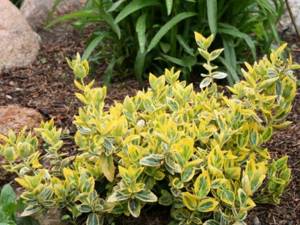
Popular varieties
Most varieties of Fortune's euonymus have variegated leaf plates. In addition, numerous varieties differ not only in appearance, but also in size, as well as resistance to cold and the ability to self-grow.
- Emerald Gold is a low-growing shrub, reaching only 30 cm in height. The leaf blades are painted emerald green with a golden or yellow edging. With the onset of autumn, the foliage acquires an unusually beautiful color: bright pink or reddish. The leaves reach 2 cm in length.
The plant normally tolerates frosts down to -25°C.
- Emerald Gaiety is also not particularly tall, growing up to 20 cm. The leaves are ovoid in shape, dark green in color with a white edge. In autumn they turn pinkish.
The variety is moderately resistant to frost.
- Silver Queen is another representative of low-growing shrubs (about 20 cm). The leaf blades are bright green with a white edge and turn pink in autumn.
"Silver Queen" tolerates frosts well, so it does not need shelter for the winter.
- Sunspot also features a squat, compact bush form. The ovate leaves are green in color with a yellow spot in the middle. The bushes do not grow much; Sunspot should be covered in winter, especially in regions with cold climates.
- Vegatus belongs to the low creeping varieties of Fortune's euonymus and is characterized by very rapid growth. The leaf blades are leathery, oval in shape, about 4 cm long. Their surface is matte, dark green in color with many whitish veins and streaks. It grows very quickly, covering the soil with a dense carpet, and also easily entwines any support.
At low temperatures it feels normal without additional shelter.
- Minimus is a mini copy of the previous variety, characterized by slow growth. Miniature compact bushes reach a height of 5 cm. Tiny leaves are about 1 cm long. The crown is painted green all year round. The plant is used as a decoration for alpine slides, rockeries, and also as borders.
- Coloratus grows up to 40 cm, and can reach up to 1.5 m in width. The leaves are oval in shape, emerald in warm weather, and purple in autumn.
The variety is distinguished by its high frost resistance.
- Variegatus is characterized by a height of 20-30 cm and green leaf blades with a white border.
- Canadale Gold belongs to tall shrubs (60-80 cm), despite this they have a compact appearance. The leaves are decorated with a yellow border.
- Harlequin is a dwarf variety of euonymus. The peculiarity of the variety is the white color of young shoots. The leaves have a very original coloring: pink, yellow and cream specks are located on the white-green surface.
Harlequin prefers shaded areas for growth.
- "Blondie" can reach from 30 to 60 cm and is characterized by rapid growth. The rich green leaves have a yellowish-white spot in the middle of the leaf. The variety blooms with tiny inconspicuous inflorescences of a greenish-yellow tone.
Popular varieties of euonymus
The euonymus is considered a universal plant, since during that period the main component of colors completely disappears in the fall, the euonymus caresses with a multi-colored crown and small colorful fruits, so similar to lanterns. And so the euonymus, planting and caring for which does not require any effort, will pamper you with sensations right up to the very frost. Before navigating the intricacies, it is necessary to analyze a couple of types of euonymus.
- Euonymus warty. It can grow as a tree (up to 6 m) or a bush (up to 3 m), on the shoots of which there are black “warts”. It blooms for the first time in late May or early June. And with the advent of August or September, the fruits of the euonymus are already visible in the form of a medium-sized pink box with dark or grayish grains. It grows slowly, is characterized by unpretentiousness and shade tolerance. Perfect for decorative purposes.
- Winged euonymus. In suitable conditions in the Far East it can grow up to 2.5 m in height as a bush and up to 4 m as a tree. In common places in Russia, the height of the euonymus is reduced by half. Contains bright emerald foliage, which turns dark scarlet in color with the arrival of autumn. The fruits have a similar color. Withstands polluted microenvironments of cities and is considered frost-resistant.
- Euonymus dwarf. It has a spreading crown and narrow leaves of a dark emerald color. By the autumn season, these varieties acquire a crimson-golden color. Euonymus fruits in the form of boxes of yellow-emerald color ripen by August or September. It stretches up to 1 m. It is considered a photophobic euonymus. Great for forming low stripes. Winter-hardy euonymus, characterized by intelligibility to the soil.
- European euonymus. It grows approximately seven meters in height in the form of a tree or bush with corky growths. Euonymus blooms with the arrival of May or June, and the first fruits appear in September. They have the appearance of ruddy-colored capsules with black, red, and white seeds. Can tolerate temporary cold temperatures down to -15°C.
- Euonymus Japanese. In suitable conditions in the south, euonymus can grow up to 7 m in height, but in the Moscow region, euonymus does not grow more than half a meter. The foliage is distinctive, dark malachite in color, with a light border. The first straw and green inflorescences bloom with the arrival of June. This euonymus is capable of growing indoors and cannot survive in temperatures below 5°C.
Famous species include the euonymus of Hamilton, Fortune, Koopman, and Bunge. It is necessary to remember that euonymus can be classified as a poisonous plant, and it has no place where there are small children.

